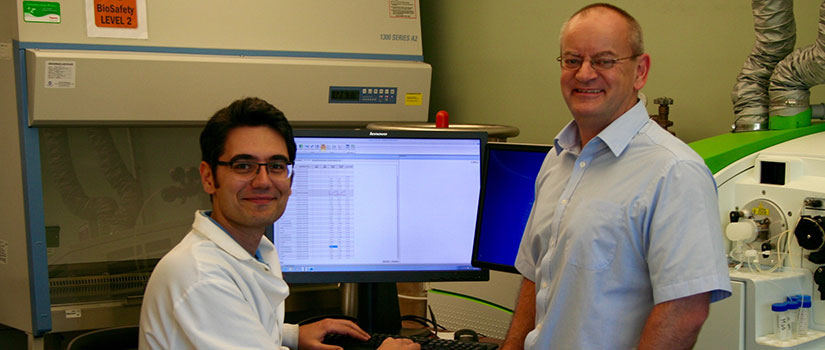November 10, 2016 | Erin Bluvas, [email protected]
Some of the most revolutionary advances in environmental cleanup methods are happening right here in South Carolina—at the University of South Carolina’s Arnold School of Public Health. Researchers in the Department of Environmental Health Sciences’ SmartState Center for Environmental Nanoscience & Risk (CENR) have now perfected their oil remediation technique, which uses nanoparticles to remove oil from both oil-water and oil-soil mixtures (see video at right for how the method works).
“We’ve overcome all of the scientific and technological challenges related to this technique,” says SmartState Endowed Chair and CENR Director Jamie Lead. “Now we’re ready to commercialize the method so that it can start benefiting environmental and human health.”
Some of the challenges the team has overcome since they unveiled their novel approach in Environmental Science and Technology nearly two years ago include scaling the technique up in size and testing it in a range of environmental conditions to confirm its efficacy outside the lab. As a result of these tests and revisions, CENR has simplified the method to include fewer steps, reduced cost through adjustments such as lowering the temperature required, and minimized the environmental impact by employing a hydrothermal method over the use of solvents that other oil remediation techniques usually rely on.
We’ve overcome all of the scientific and technological challenges related to this technique. Now we’re ready to commercialize the method so that it can start benefiting environmental and human health.
-Jamie Lead, CENR Director
“Our priority is to harness nanoparticles in such a way that they minimize environmental hazards and maximize benefits,” explains Lead. “We’re not just thinking about the immediate impact on the area around the contamination site but on the entire life cycle of the product in terms of how it will impact the environment.”
The researchers have tested samples obtained from polluted marine and fresh water as well as soil samples, such as those from a contamination site at Fort Jackson. The efforts to scale up the application of the cost-effective technique allows it to be applied to not only catastrophic oil spills, like the 2010 Deepwater Horizon Oil Spill which was accompanied by an estimated cleanup cost of more than $14 billion, but also everyday contexts that might not make the news but garner their own hefty price tags over time.
“This method can be applied in chronic or persistent situations, such as runoff from roads or discharge from factories or ships,” says Lead. “It can even be used preventively to protect high-value or otherwise vulnerable settings.”
In addition to utilizing the technique preemptively, the method offers other options. For example, it can be employed by inserting the nanoparticles into the environment, allowing them to adhere to the oil, and then removing the oil and the nanoparticles using magnets.
We’re not just thinking about the immediate impact on the area around the contamination site but on the entire life cycle of the product in terms of how it will impact the environment.
-Jamie Lead, CENR Director
Alternatively, nanoparticles can be purposefully left in the environment where they will stimulate the growth of specific types of bacteria, which break down the oil and lead to a better long-term result for oil removal in certain situations. In both cases, the nanoparticles can remove much of the toxicity. In these ways, the new technology overcomes the difficulties that current treatment methods face.
Regardless of which variation of the technique is applied, the flexible approach results in a drastic reduction in oil and oil toxicity by up to 95 percent. The nanotechnology uses non-toxic materials, and the nanoparticles are not toxic.
Finally, CENR researchers have calculated that costs can be reduced by up to 80-90 percent compared to current remediation methods. When the oil, which is highly toxic, is removed from the environment, its toxicity is removed as well—along with the threat to the environment. In fact, even if the approach is delayed in its application until a few days after the contamination occurs, it still results in a 30-60 percent reduction in toxicity for the surrounding environment.
This method can be applied in chronic or persistent situations, such as runoff from roads or discharge from factories or ships. It can even be used preventively to protect high-value or otherwise vulnerable settings.
-Jamie Lead, CENR Director
Since CENR published its first paper on the technique in late 2014, the team has published two additional papers (i.e., Environmental Science: Nano, Environmental Science and Technology) in scientific journals (with four more in preparation or submitted) and submitted a second patent. “I’ve always wanted to develop a novel technique for solving real environmental problems,” says Seyyedali Mirshahghassemi (pictured above, left, with Lead in the CENR lab), a graduate research assistant with CENR and first author on the Environmental Science and Technology paper that discussed the team’s work to scale up the approach. “Under Dr. Lead’s mentorship, we have overcome various scientific and technical challenges to create an innovative, nanotechnology-based cleanup method that works in realistic conditions.”
CENR has recently added “soil scientist” Buzz Kloot to its roster of faculty, expanding their team to six faculty members and around 20 doctoral students and postdoctoral fellows—a rapid increase from when Lead founded the SmartState Center as the sole researcher in 2012. Though the technique has numerous applications, including the ability to remove metals from the environment using the same process, CENR is already in talks to collaborate with an industry partner to bring the oil remediation application to market—and concurrently to the public’s benefit—as soon as possible.
